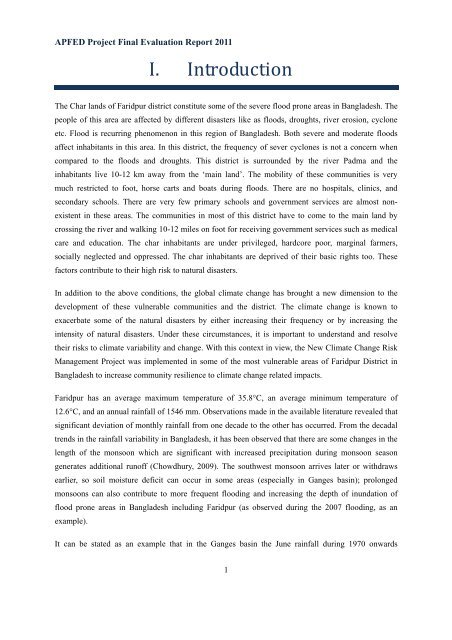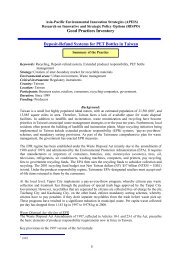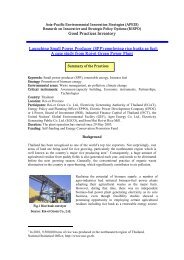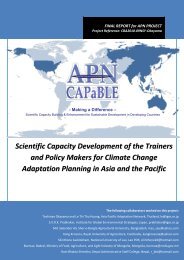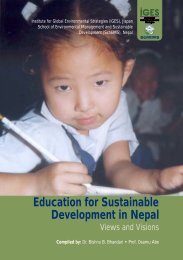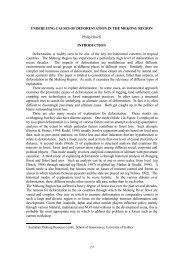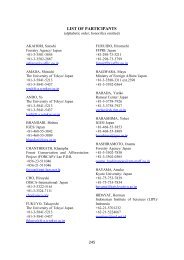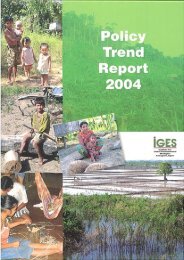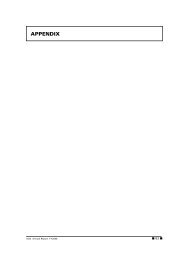final evaluation report akk_iges_final.pdf - IGES EnviroScope
final evaluation report akk_iges_final.pdf - IGES EnviroScope
final evaluation report akk_iges_final.pdf - IGES EnviroScope
You also want an ePaper? Increase the reach of your titles
YUMPU automatically turns print PDFs into web optimized ePapers that Google loves.
APFED Project Final Evaluation Report 2011<br />
I. Introduction<br />
The Char lands of Faridpur district constitute some of the severe flood prone areas in Bangladesh. The<br />
people of this area are affected by different disasters like as floods, droughts, river erosion, cyclone<br />
etc. Flood is recurring phenomenon in this region of Bangladesh. Both severe and moderate floods<br />
affect inhabitants in this area. In this district, the frequency of sever cyclones is not a concern when<br />
compared to the floods and droughts. This district is surrounded by the river Padma and the<br />
inhabitants live 10-12 km away from the ‘main land’. The mobility of these communities is very<br />
much restricted to foot, horse carts and boats during floods. There are no hospitals, clinics, and<br />
secondary schools. There are very few primary schools and government services are almost nonexistent<br />
in these areas. The communities in most of this district have to come to the main land by<br />
crossing the river and walking 10-12 miles on foot for receiving government services such as medical<br />
care and education. The char inhabitants are under privileged, hardcore poor, marginal farmers,<br />
socially neglected and oppressed. The char inhabitants are deprived of their basic rights too. These<br />
factors contribute to their high risk to natural disasters.<br />
In addition to the above conditions, the global climate change has brought a new dimension to the<br />
development of these vulnerable communities and the district. The climate change is known to<br />
exacerbate some of the natural disasters by either increasing their frequency or by increasing the<br />
intensity of natural disasters. Under these circumstances, it is important to understand and resolve<br />
their risks to climate variability and change. With this context in view, the New Climate Change Risk<br />
Management Project was implemented in some of the most vulnerable areas of Faridpur District in<br />
Bangladesh to increase community resilience to climate change related impacts.<br />
Faridpur has an average maximum temperature of 35.8°C, an average minimum temperature of<br />
12.6°C, and an annual rainfall of 1546 mm. Observations made in the available literature revealed that<br />
significant deviation of monthly rainfall from one decade to the other has occurred. From the decadal<br />
trends in the rainfall variability in Bangladesh, it has been observed that there are some changes in the<br />
length of the monsoon which are significant with increased precipitation during monsoon season<br />
generates additional runoff (Chowdhury, 2009). The southwest monsoon arrives later or withdraws<br />
earlier, so soil moisture deficit can occur in some areas (especially in Ganges basin); prolonged<br />
monsoons can also contribute to more frequent flooding and increasing the depth of inundation of<br />
flood prone areas in Bangladesh including Faridpur (as observed during the 2007 flooding, as an<br />
example).<br />
It can be stated as an example that in the Ganges basin the June rainfall during 1970 onwards<br />
1


